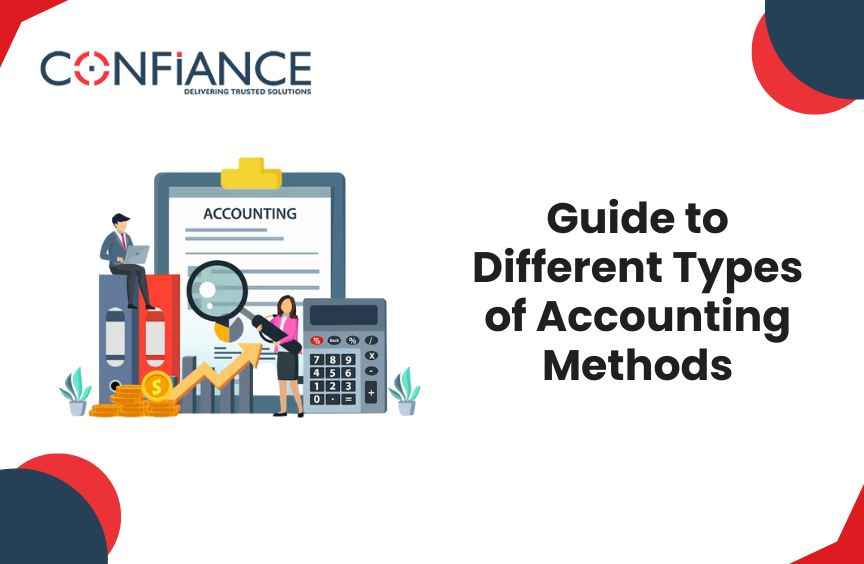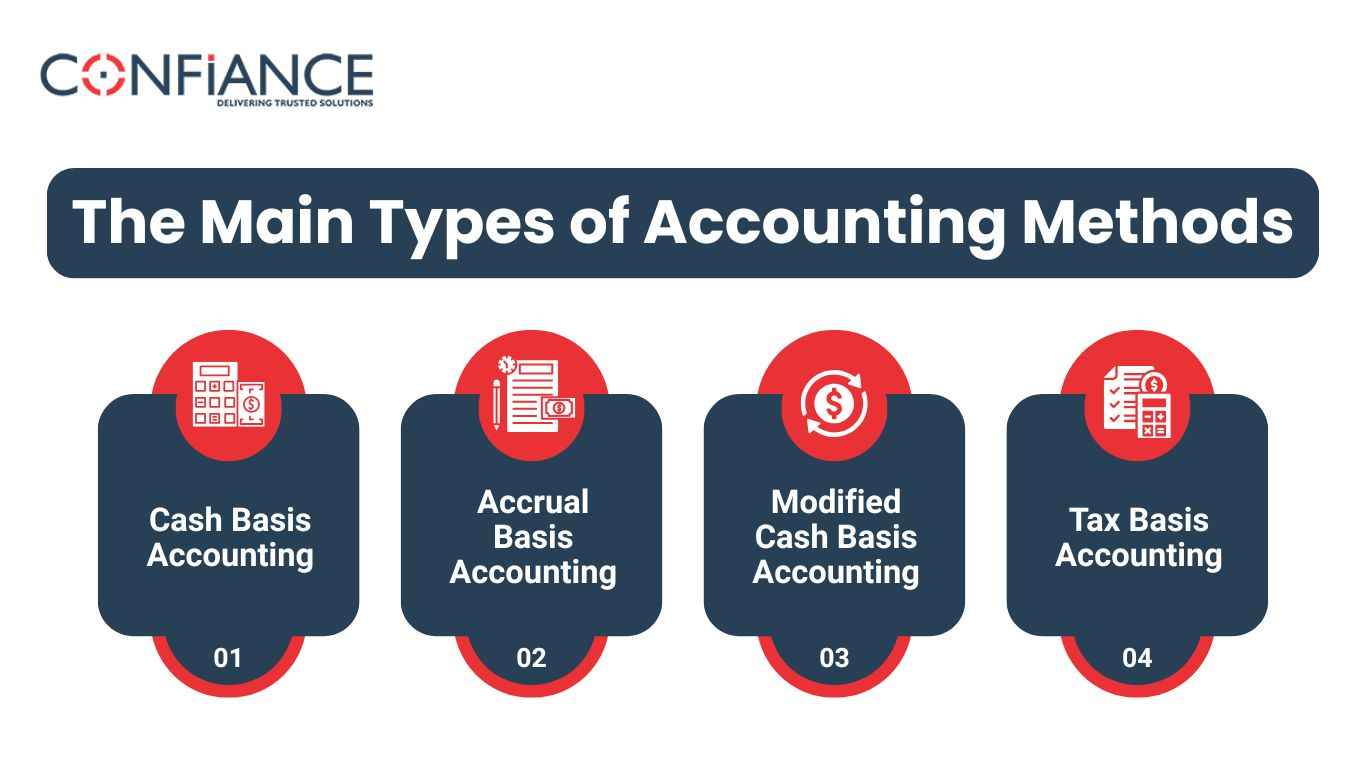
Guide to Different Types of Accounting Methods
Accounting is how a business records and reports its financial activities. Every company must pick an accounting method that fits its operations and meets tax rules. The choice affects how income and expenses appear on reports and when they are recorded. There are multiple types of accounting methods that can benefit your business in different ways. Choosing the right method can shape decisions, affect cash flow, and determine tax obligations.
In this blog, we will explain the main types of accounting methods. We break down how each works, where it fits best, and what rules apply. Understanding these methods will help you pick the one that fits your business or improve the one you already use.
What Are Accounting Methods?
Accounting methods are rules for recording income and expenses. Businesses must stay consistent with the method they choose unless they get approval from tax authorities to switch. The method sets the timing of when transactions are recorded, not whether they are recorded.
Some methods work better for small businesses, while others are required for corporations or firms with complex inventories. Choosing the right method supports better recordkeeping and makes financial reporting easier.
Why It Matters
Accounting methods impact more than just the books. They affect:
- When income is taxed
- How cash flow appears on statements
- How expenses align with income
- Compliance with tax laws
- Inventory valuation and profit calculation
For example, a company using cash basis accounting might look profitable one month and weak the next, depending on when payments are made or received. A company using accrual accounting shows income and expenses when earned or incurred, which gives a more stable view.
The Main Types of Accounting Methods
There are four core methods used in accounting. Each serves a different purpose and fits a different type of business structure.
1. Cash Basis Accounting
Definition:
Cash basis accounting records income when it is received and expenses when they are paid.
How It Works:
If a customer pays in January, the income is recorded in January. If you buy supplies in February and pay right away, the cost shows in February.
Best For:
Small businesses with simple transactions and no inventory. It works well for sole proprietors, freelancers, and service providers.
Advantages:
- Simple to use
- Matches bank activity
- Helps manage cash flow
Disadvantages:
- Not allowed for some corporations
- Can distort income and expenses
- Not useful for inventory tracking
Tax Rule:
The IRS allows this method for small businesses with gross receipts under a set limit, currently around 25 million dollars.
2. Accrual Basis Accounting
Definition:
Accrual accounting records income when it is earned and expenses when they are incurred, regardless of when money is exchanged.
How It Works:
You invoice a client in March. You record income in March, even if they pay in April. If you get a bill in May, the cost shows in May, even if you pay in June.
Best For:
Businesses with inventory, many transactions, or sales on credit. Required for many corporations and partnerships.
Advantages:
- Gives a clearer view of income and expenses
- Matches income with related costs
- Required for many regulatory reports
Disadvantages:
- More complex
- Can hide cash flow issues
- Needs good tracking systems
Tax Rule:
Required for many companies with inventory or high revenues. It must be used by businesses that do not meet the cash method test.

3. Modified Cash Basis Accounting
Definition:
This method combines features of both cash and accrual basis accounting.
How It Works:
Income and expenses are recorded on a cash basis. However, fixed assets and liabilities may be recorded using the accrual method. Some items like loans or large purchases are handled with more detail than basic cash accounting allows.
Best For:
Businesses that want simplicity but need more detail in some areas. Often used by growing businesses or firms shifting from cash to accrual methods.
Advantages:
- Offers flexibility
- Easier than full accrual
- Gives more detail than cash alone
Disadvantages:
- Not recognized under GAAP
- Cannot be used for official tax reporting
- May confuse readers if not explained well
4. Tax Basis Accounting
Definition:
This method follows tax rules set by the IRS instead of standard financial reporting rules.
How It Works:
Income and expenses are recorded as required by tax laws. This often means using elements of both cash and accrual methods but following IRS rules for deductions, depreciation, and timing.
Best For:
Firms that want their financials to match their tax filings.
Advantages:
- Matches tax returns
- Reduces effort at year-end
- May lower tax burden through careful timing
Disadvantages:
- Not allowed for GAAP reports
- May not show accurate financial health
- Hard to compare with industry benchmarks
Other Methods and Variations
Besides the main accounting methods, some businesses use specialized techniques to support internal tracking or meet industry needs.
Completed Contract Method
Used in construction and long-term projects. Income and expenses are reported only when the contract is complete.
Pros:
- Delays tax on income
- Useful when project timing is unclear
Cons:
- Can create irregular income
- Not allowed for some companies
Percentage of Completion Method
Also used in long-term projects. Income and expenses are recognized based on project progress.
Pros:
- Shows earnings as work is done
- Smooths out revenue
Cons:
- Needs careful tracking
- Can be misused if not monitored
Cost Method and Equity Method
These are used for tracking investments in other businesses. The choice depends on how much control one company has over another.
Choosing the Right Accounting Method
Several factors help decide which method to use:
- Business Type:
Sole proprietors can use simple methods. Corporations must follow stricter rules.
- Revenue Size:
Large businesses often cannot use the cash method.
- Inventory Use:
Businesses that sell goods must often use accrual methods.
- Tax Goals:
Some methods shift income and expenses in ways that reduce tax bills.
- Financial Needs:
Investors and lenders may require full accrual reports.
- Software and Skills:
Accrual methods need stronger tools and more training.
Always check with a tax advisor or accountant before picking or switching methods. Once chosen, the method must stay consistent unless you get IRS approval to change it.
Switching Between Methods
To switch methods, you must file Form 3115 with the IRS. This applies even when switching from cash to accrual or vice versa. Changes affect how income is recorded, and the IRS must approve the change to avoid penalties.
You will need to adjust records so there is no double counting or missed items. The IRS calls this a “Section 481(a) adjustment.” It helps bridge the difference between the two methods.
Switching may offer tax benefits, but only if done correctly.
Accounting Methods Under GAAP
GAAP stands for Generally Accepted Accounting Principles. These are the rules used for financial reports in the United States.
Only accrual basis accounting meets GAAP standards. Public companies, lenders, and investors often require GAAP-compliant reports.
Even small companies may use accrual methods for internal reports while using cash methods for taxes.
Accounting Methods and Financial Reporting
Your choice affects more than tax. It impacts every report used for planning, budgeting, and financial tracking. Some areas where accounting methods matter:
- Profit and Loss Reports: Cash methods may understate or overstate profits in any given period.
- Balance Sheets: Accrual accounting gives a fuller view of liabilities and assets.
- Cash Flow Statements: Even with accrual accounting, businesses still need to track actual cash flow.
Good software can help translate one method into another for reporting. This lets business owners plan wisely while staying compliant with tax rules.
Common Mistakes in Using Accounting Methods
- Mixing Methods:
Do not record income using one method and expenses using another unless using a recognized hybrid.
- Switching Without Approval:
You must report and get IRS approval before switching.
- Wrong Inventory Treatment:
If your business sells goods, you likely cannot use the cash method alone.
- Poor Recordkeeping:
Each method requires tracking. If data is missing or unclear, reports lose value.
- Ignoring Updates:
Tax rules change. The income threshold for using cash basis accounting has risen in recent years.
Understanding different types of accounting methods helps in making better decisions, keeping records clear, and staying compliant with rules. The cash basis method works well for simple needs. The accrual method gives more insight. Hybrid and tax basis options serve specific cases.
Choose a method that matches your business goals, size, and tax situation. Review your choice with an expert, especially if your company is growing or changing. The method you choose shapes how you see your business and how others see it too.
FAQs
- What are the main types of accounting methods?
The main types are cash basis, accrual basis, modified cash basis, and tax basis accounting. - Can small businesses use cash basis accounting?
Yes, most small businesses can use the cash basis if their revenue stays under IRS limits. - Is accrual accounting required for all companies?
No, but it is required for companies with inventory or high revenue. It is also needed for GAAP compliance. - What is the difference between cash and accrual accounting?
Cash accounting records money when it moves. Accrual accounting records when income is earned and expenses occur. - Can I change my accounting method later?
Yes, but you need IRS approval by filing Form 3115 and adjusting past records. - Which method is best for financial planning?
Accrual accounting gives a clearer picture for planning because it shows income and expenses when they happen, not just when cash moves.
